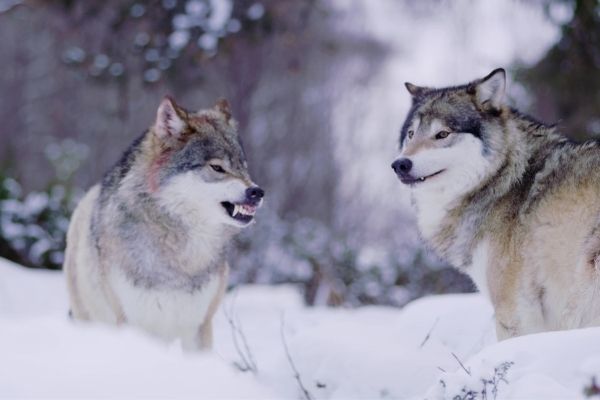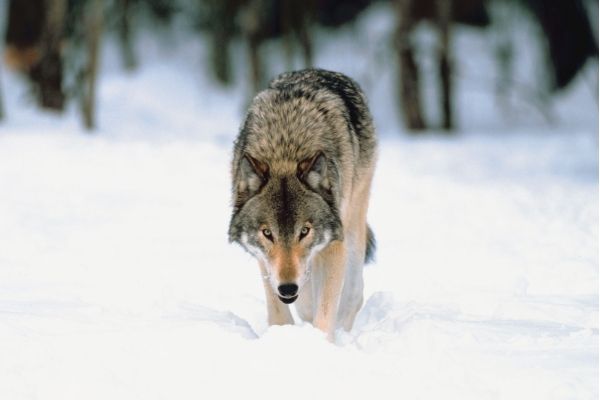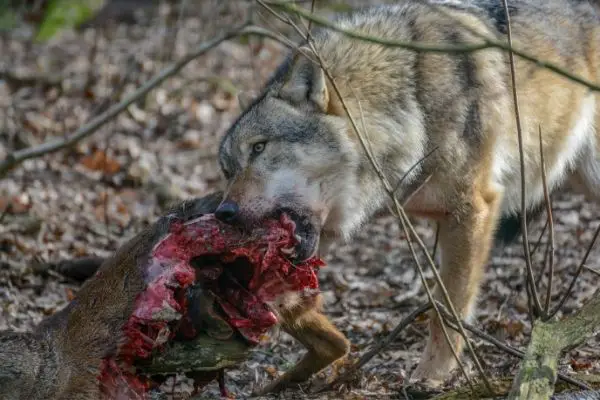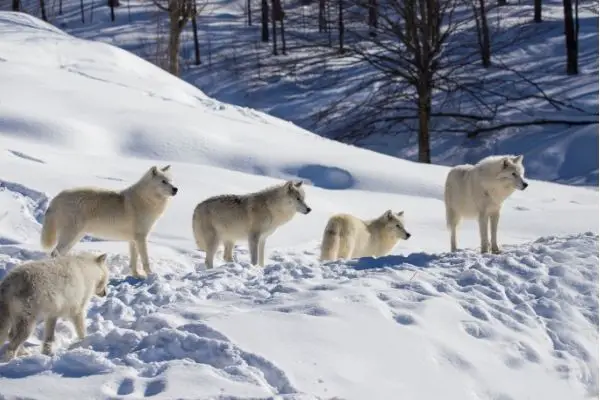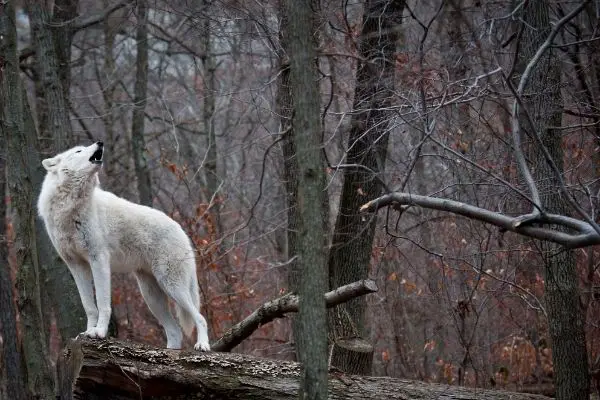Gray wolf is the largest wild member of the dog family, which is called Canidae. It is native to Eurasia and North America, with more than thirty subspecies. We have listed down complete Gray Wolf Facts for Kids that will help you in learning all about Gray Wolves. You are going to learn about its scientific name & classification, evolution, appearance, physical features, physical abilities, diet, habitat, lifespan, reproduction, babies, behavior, adaptations, food chain, ecological role, endangerment, population, predators, and many other interesting facts about Gray Wolves.
Gray Wolf Facts For Kids
What is a Gray Wolf
- The gray wolf is a large canine species indigenous to Eurasia and North America.
- It is also known as a timber wolf or just the wolf.
- It is the largest living wild member of the dog family Canidae.
- There are more than 30 recognized subspecies of gray wolves.
- In 2003, the estimated worldwide population of grey wolves was 300,000 individuals.
- That is why the IUCN Red List considers the species as Least Concern.
Scientific Name
- The scientific name of the gray wolf is Canis lupus.
Scientific Classification
The following is the scientific classification or taxonomy of gray wolf:
| Kingdom | Animalia |
| Phylum | Chordata |
| Subphylum | Vertebrata |
| Class | Mammalia |
| Order | Carnivora |
| Family | Canidae |
| Genus | Canis |
| Species | Canis lupus |
Evolution Of Grey Wolf
- It is widely accepted that the phylogenetic ancestor of the living grey wolf (Canis lupus) is Canis etruscus, from which it descended through Canis mosbachensis.
- Fossils were excavated at Old Crow, Yukon, Canada, and at Cripple Creek Sump, Fairbank, Alaska (USA) are thought to be the earliest fossils of Canis lupus. The age of the fossil is not agreed upon, but it could date back to about 1 million years ago.
- By the Late Pleistocene, there was significant morphological diversity among wolves. Their skulls and teeth were more robust than the modern wolves, while their snouts were shortened, and their premolars were also more robust.
- Around 70,000 to 23,000 years ago, grey wolves migrated to North America.
- Genetic studies suggest that there was a common ancestral wolf population of the modern wolves and dogs that existed around 20,000 years ago.
- A genomic study in 2016 suggests that New Word wolves split from the Old World wolves about 12,500 years ago. Then about 12,300 to 11,100 years ago, it led to the divergence of dogs from other Old World wolves.
- Probably, the ancestor of the dog was an extinct Late Pleistocene wolf. The similarity of the dog to the living wolf may be the result of genetic admixture between the two.
- The estimated time for the divergence of wolves in Asia, the Middle East, and Europe is around 1,600 years ago, which is fairly recent.
What Does Gray Wolf Look Like
Appearance
- In appearance, a gray wolf somewhat looks like a German shepherd.
- It has a robust body and a heavily muscled neck.
- It has a shorter torso, long tail, and moderately long legs than other canids.
- A gray wolf has a large heavy head, with a broad forehead, small triangular ears, pointed blunt muzzle, and strong jaws.
- Gray wolves have large and heavy teeth, which are excellent for crushing bones.
- Female individuals have narrow foreheads and muzzles, thin necks, less massive shoulders, and slightly short legs than male individuals.
- The body of the gray wolf is covered with thick fur, which becomes denser and fluffy in the winter. The fur has two layers; a short undercoat and long guard hairs.
- Their front quarter and neck have long hair. Hairs on the shoulders are especially long and form a crest on the upper region of the neck. On the cheeks, the hairs are slightly elongated and form tufts.
Color
- The coat color of the gray wolves is the color of their gaur hairs.
- Usually, they have some hairs of white, grey, black, and brown colors.
- In Eurasian wolves, the coat color is a mixture of yellow-to-orange and orange-red-brown (rusty ochreous) colors with light-grey. The chin, lips, cheeks, and throat is white while the muzzle is pale yellow-to-orange gray. Their forehead, top-head, regions under and between the eyes, and between the ears and eyes are reddish-grey.
- The tail, body sides, and outer sides of the legs have pale dirty ocherous (yellow-to-orange) color.
- The undersides of the legs and body are usually yellow-white.
- Besides those wolves, who have pure black or white color, the color tones change very slightly across geographical regions. However, the patterns of these colors change between individuals.
Physical Features
Height
- The shoulder height of adult wolves measures from 31 to 33 inches (80 to 85 cm).
Length
- The head-and-body length of adult gray wolves ranges from 41 to 43 inches (105 to 160 cm).
- The length of the tail ranges from 11 to 20 inches (29 to 50 cm).
Weight
- The average bodyweight of the wolves is about 40 kg (88 lbs).
- The recorded largest specimen weighed 79.4 kg (175 lbs) while the smallest was only 12 kg (26 lbs).
- The weight and size of the modern wolves increase with latitude, according to Bergmann’s Rule.
- The average bodyweight of the European wolves is 38.5 kg (85 lbs), of the North American wolves is 36 kg (79 lbs), and of the Arabian and Indian wolves is 25 kg (55 lbs).
- Male individuals in any given population of wolves usually weigh 2.3 to 4.5 kg (5 to 10 lbs) larger than females.
- The maximum bodyweight of the exceptionally large males in middle Russia was given from 69 to 79 kg (152 to 174 lbs).
Physical Abilities of Gray Wolves
Speed
- The normal traveling speed of gray wolves is about 8 km/h (5 miles per hour).
- While they can run at the speed of 50 to 60 km/h.
- Their maximum speed is about 64 km/h (40 miles per hour).
Jump
- Gray wolves can jump around 12 feet (3.6 meters) high in the air while covering about 15 feet (4.5 meters) distance.
Climb
- Grey wolves can not climb trees.
Swim
- Gray wolves are excellent swimmers.
- In coastal regions, they swim for miles between the islands and rocky outcrops to find and eat the carcasses of seals and other animals.
What do Gray Wolves Eat
Diet
In wild
- Gray wolves are carnivores in nature and obtain most of their nutritional requirements from the meat of other animals. However, they also eat some foods of plant origin.
- They are pack hunters, and all members of the pack hunt together.
- They predominantly prey on wild herbivorous hoofed mammals.
- Their large size prey may have bodyweight from 240 to 650 kg (530 to 1,430 lbs), while their medium-size prey may have 23 to 130 kg (51 to 287 lbs) body weight.
- Their large size prey usually have around similar body weight to the combined bodyweight of the pack members.
- Gray wolves usually hunt on vulnerable individuals of large size prey.
- A pack of 15 individuals can bring down a full-grown moose.
- Their diet varies according to their habitat in different continents.
- North American wolves usually eat large wild hoofed mammals as well as medium-sized mammals.
- In Europe and Asia, they usually hunt wild hoofed mammals of medium size as well as domestic species.
- Wolves also eat carrion in case of food scarcity.
- In regions with dense human activity, they prey on livestock and also eat garbage.
- Cannibalism is also common in wolves. When it is difficult for them to find prey usually in harsh winters, packs often attack an injured or weak wolf. They are also known for eating the carrion of pack members.
- European wolves consume pears, figs, apples, melons, cherries, and barriers.
- In-plant matter, the North American wolves consume blueberries and raspberries.
- They are also known for eating grasses, which may provide some vitamins.
In captivity
- At the Smithsonian National Zoo, gray wolves are fed with meat, bones, fish, dry canine kibbles, frozen prey animals (mostly rabbits), and vegetables.
- They eat around 4 to 5 pounds of food per day in captivity.
List of food items
- Wolves usually eat herbivore ungulates (hoofed mammals).
- In Eurasia, their most common prey species are moose, wild boar, red deer, and roe deer.
- In North America, the most common prey species are moose, elk, mule deer, caribou, and white-tailed deer.
- They also eat small-sized animals, such as hares, rodents, insectivores, small carnivores (weasels, ferrets, etc.), waterfowls, and their eggs.
- In case of insufficient food, they will also eat frogs, lizards, snakes, and large insects.
- In the coastal regions, such as in Alaska and British Columbia, fish and other foods of marine sources make 20 to 25% of their diet.
- In-plant matter, they eat fruits and berries (such as figs, pears, melons, blueberries, raspberries, and apples, etc.) and various types of grasses and grain crops.
How much Gray Wolves Eat per day
- A gray wolf requires 5 to 7 pounds of food per day.
- It can survive on about two to half pounds of food per day.
- In one meal, a large adult gray wolf can eat as much as about 22 pounds of food.
- Gray wolves eat several times per day and digest their food in several hours.
What does baby Gray Wolf Eat?
- A baby gray wolf eats his mother’s milk for the first days of his life.
- When he has his first teeth milk at the age of about 2 weeks, he starts eating small pieces of regurgitated meat.
Where do Gray Wolves Live – Gray Wolf Habitat
Natural Habitat
- Gray wolves were originally native to Eurasia and North America.
- They are now locally extinct in many regions of the United States, Mexico, Western Europe, and Japan.
- Currently, they are found in the wilderness and remote areas.
- Their natural habitat regions can be between the sea level and the elevation of 3,000 meters (9,800 feet).
- The habitats that grey wolves use to live in depends on the abundance of the prey, densities of livestock, human presence, road densities, snow conditions, and topography.
Biome
- Gray wolves have been known to survive and are well-adaptable to all types of biomes except the tropical forests.
- They live in the biomes of forests, shrublands, grasslands, and Arctic tundra, inland wetlands, pastures, rocky peaks on the mountains, and the desert.
Range
- In North America, gray wolves are found primarily in Alaska, Canada, and the northern United States.
- In Europe, the habitat range of gray wolves covers about 28 countries.
- In Asia, their habitat range covers entire Russia, regions in Central Asia, Eastern Asia, and parts of the Arabian Peninsula.
Countries List
- In North America, gray wolves are found in the United States, Canada, and Mexico.
- In Europe, they are found in more than 28 countries. Major and large populations are found in Portugal, Spain, Italy, Germany, France, Poland, Belarus, Ukraine, Romania, Bulgaria, Greece, North Macedonia, and Russia.
- In Asia, gray wolves are found in Mongolia, China, Kazakhstan, Kyrgyzstan, Turkmenistan, Uzbekistan, Tajikistan, and India.
- In the Middle East, gray wolves are found in Saudi Arabia, Iran, Iraq, Syria, Lebanon, Jordan, and Israel.
Gray Wolf Lifespan
In Wild
- The average lifespan of gray wolves in the wild is 6 to 8 years.
- They live for a maximum age of 13 years in the wild.
In Captivity
- The average lifespan of gray wolves in captivity is 17 years.
- While their maximum lifespan in captivity is up to 20 years.
Gray Wolf Life Cycle
- The lifecycle of gray wolves starts when they are born after a gestation period of 62 to 75 days.
- At the age of 3 years, they sexually mature and start breeding.
- They produce a litter of pups every year.
- Gray wolves live for a maximum age of about 13 years in the wild.
Gray Wolf Reproduction
- Gray wolves are monogamous and the mating pairs stay together for life.
- Females usually reproduce every year.
- Gray wolves usually built dens for pups during the summer season. To build a den, they usually use natural shelters, such as holes covered thickly with vegetation, fissures in the rocks, and rock cliffs hanging outwards over the riverbanks. Sometimes, they use appropriate burrows of the smaller animals (like badgers, foxes, and marmots) as a den, which they remade and widened. Rarely, females themselves dig burrows. The dense is usually built away from the peripheral zone of their territories.
- A pregnant female stays in the den to avoid violent encounters with other packs.
- After the gestation period of 62 to 75 days, females give birth to a litter of pups.
- The litters of young females have 4 to 5 pups, while the litters of older females have 6 to 8 pups. The maximum number of pups in a litter is up to 14.
Gray Wolf Baby
- A gray wolf baby is known as a pup.
- The gray wolf pups are born in the form of litter after a gestation period of 62 to 75 days.
- At birth, they look like the pups of the German Shepherd dog.
- They are born blind and deaf and start to see after 9 to 12 days.
- Their bodies are covered with soft fur of greyish-brown color.
- Every newborn pup weighs 300 to 500g.
- The mother feeds the newborn pups with her milk.
- For the first few weeks, mothers do not leave the den and depend on the father to provide food for her and the pups.
- After about 3 weeks, the pups leave the den for the first time.
- Their milk canine teeth erupt at the age of one month.
- Pups start eating solid food at the age of 3 to 4 weeks.
- At the age of 1.5 months, the pups become agile enough to escape from danger.
- During the first four months of life, pups have an extremely fast growth rate, and their weight increases around 30 times.
- They start play-fighting at the age of 3 weeks, while the actual fight for the establishment of hierarchy usually occurs at the age of five to eight weeks.
- The mortality rate of gray wolf pups is 60 to 80%.
- The pups are sexually mature at the age of about 3 years.
Gray Wolf Adaptations
Physical OR Structural Adaptations
Fur
- Gray wolves have two-layered thick fur composed of short undercoats and long rough guard hairs.
- Their fur becomes more fluffy and denser in the winter season to keep them warm and insulated.
- In spring, most of the undercoat and guard hair is shed and their overall fur becomes scarcer and coarser as they do not need insulation in the summer. In the autumn, it then grows back and becomes denser.
Coat Color
- The coat color of gray wolves depends on the location of their habitat.
- It is usually of light-brown or gray color, but may also be white and black.
- Their coat color blends in with the surroundings and provides them camouflage during hunting and against predators.
Strong Jaws and Sharp Teeth
- Gray wolves have powerful jaws and sharp teeth that are well-adapted for hunting.
- They use their teeth to hunt and crush the bones of the prey.
Padded Paws and Sharp Claws
- Gray wolves have well-adapted fleshy padded paws, which provide better support while walking on rough terrain.
- Their paws are equipped with sharp claws, which provide grip on the ground and are also used during hunting and fighting.
Physiological Adaptations
Reduction of Blood Flow To Skin
- In cold climates, the blood flow to the skin of wolves reduces.
- It allows them to conserve body heat.
Countercurrent Heat Exchange System in the Legs
- Wolves have a countercurrent heat exchange system in the legs.
- In cold seasons and snowy climates, the blood coming to their legs warms the blood leaving their legs.
- This system reduces the loss of energy and conserves heat.
Fat Reservoir
- Gary wolves feed well when food is abundantly available.
- They store extra food in the form of fats under their skin, around their intestines, kidneys, heart, and bone marrow.
- In case of food scarcity, they get energy from this fat reservoir and become able to survive in harsh conditions.
Keen Senses of Smell and Hearing
- Gray wolves have extremely keen senses of smell and hearing.
- Their sense of smell is around 100 times sharper than humans. It helps them to locate prey and predators from a large distance.
- Their hearing sense is about 20 times greater than humans.
- Both senses allow them to detect even small changes in their environment.
- It also helps them to avoid predators and violent encounters with other packs.
Sharp Sense of Vision
- Wolves have a sharp sense of vision.
- Their eyes are extremely sensitive to movements.
- Their reflective retinas improve their night vision and help them to hunt in the dark as well as to avoid predators.
The behavior of Gray Wolf
Social Structure
- Gray wolf is one of the most social carnivore species.
- They live in groups known as packs.
- A pack is essentially a nuclear family and consists of the mating pair and their offspring.
- Usually, a pack has 5 to 8 members. However, it may have as many as 36 members.
- The mating pair dominates the pack and is known as the dominating pair or the alpha male and alpha female.
- The dominating pair usually starts activities, guides the movements of the pack, and controls critical situations during the hunt. The parents teach their offspring how to hunt, avoid threats, survive, and mark territories.
- Besides the dominating pair, other wolves in a pack have a dominance hierarchy.
- Only the dominating pair mate within the pack, however, if a pack is large, other members also get the opportunity of mating.
Territory
- Wolves are territorial and vigorously defend their territory against other packs.
- Depending on the availability of prey, the territory of a pack can be 80 to 3,000 k㎡ (31 to 1,200 square miles).
- They mark their territories with urine, feces, and scratch marks to let the other packs know they should not intrude.
Communication
- Gray wolves communicate through a variety of visual, olfactory, and auditory ways.
- They make howling, barking, and growling sounds. A wolf barks to warn other wolves or in case of a threat. Growling is used to challenge other wolves. Through howling, they communicate with other packs from large distances and keep them away from the territory. A wolf can detect the distance of other packs from hearing howls. Howling is also used to keep the pack members together. Through howling, a lost wolf can return to its pack.
- To show dominance on the other pack members, a dominant wolf partly erects its tail, walks while holding its head high, and keeps its eyes straight towards other wolves.
- To show sub ordinance, grey wolves make several postures, like a lowered body position, lowered tail, walking with small steps toward dominant members, an exposed throat, and folded ears backward.
How Do Gray Wolves Protect Themselves
- Wolves have strong muscular bodies, sharp teeth, and claws, which they used to protect themselves.
- They have an extremely keen sense of smell and have the ability to detect threats and predators from a large distance.
- Males wolves have around 20% larger body size than females and are physically strong. Studies found that they can protect their packs by fighting with other rival packs.
Gray Wolf Food Chain
- In the food chain of gray wolves, the sun is the overall source of energy.
- Producers are green plants that take energy from the sun and prepare food for themselves through photosynthesis.
- Primary Consumers in this food chain are large herbivore animals (hoofed mammals), rodents, small herbivore animals ( such as rabbits and hares), and fish. They consume producers (plants or foods of plant origin) as their primary source of diet.
- Secondary Consumers in this food chain are small carnivores, such as raccoons, ferrets, weasels, and otters, etc.
- Tertiary Consumers are the grey wolves. They consume secondary consumers as well as primary consumers.
Ecological Role of Gray Wolf
- Gray wolves play a major role to keep the ecosystem healthy.
- Their major prey is herbivore animals. They keep the population of their prey in control and benefit many plants as well as animal species to flourish.
- They leave some of the carcasses of their prey, which provide food for other wildlife species (such as grizzly bears) and scavengers.
- Their thriving in an ecosystem indicates the health of that ecosystem.
The population of Gray Wolf
- The worldwide estimated wild population of the gray wolves was 300,000 in 2003.
Why Are Gray Wolves Endangered
Reasons
Gray wolves are not endangered. However, their population is declining due to several reasons. The major reasons are:
- They are losing their habitat because most of the grazing land of their prey is occupied for agriculture.
- People kill them like pests because they are a threat to their livestock.
Conservation status
- The conservation status of Gray wolves on the IUCN Red List as Least Concern.
Gray Wolf Predators
- Besides humans, there are no significant predators of the gray wolves.
- Coyotes usually attack and kill lonely or younger wolves.
- Some big cats, such as Siberian tigers and cougars, attack and fight with packs of gray wolves. However, the nature of the attack seems to be competitive rather than predatory. Usually, big cats dominate in such disputes.
- Gray wolves also fight with brown bears and striped hyenas over carcasses. If the wolf is alone, brown bear and hyena dominate the disputes. However, if there is a wolf pack on one side and a brown bear or hyena on the other side, the wolves mostly win the disputes.
Fun Facts About Gray Wolves
- Gray wolf is the largest living wild member of the dog family Canidae.
- From bulldogs to poodles, wolves are the ancestors of all the domesticated dog species.
- Wolves are one of the most social animal species and live in groups known as packs.
- A gray wolf can hear the howl of other wolves at the distance of 10 to 11 km (6 to 7 miles).
- It is a popular belief that wolves howl at the moon. However, it is not true and they use howls to communicate.
- Through howls, a pack gauge distance and warn other packs to stay away from its territory.
- Howls are also used to solidify bonds within a pack and to combine all the pack members. A lost pack member can return via detecting and following the howls.
- The sense of smell of the gray wolves is 100 times greater than humans. The smell receptive part in a wolf nose is about 14 times greater than a human nose.
- Under favorable atmospheric conditions, a wolf can detect a scent from a distance of about 1.75 miles.
- The traveling speed of wolves is about 8 kilometers (5 miles) per hour. However, they can run at the fastest speed of about 64 kilometers (40 miles) per hour.

